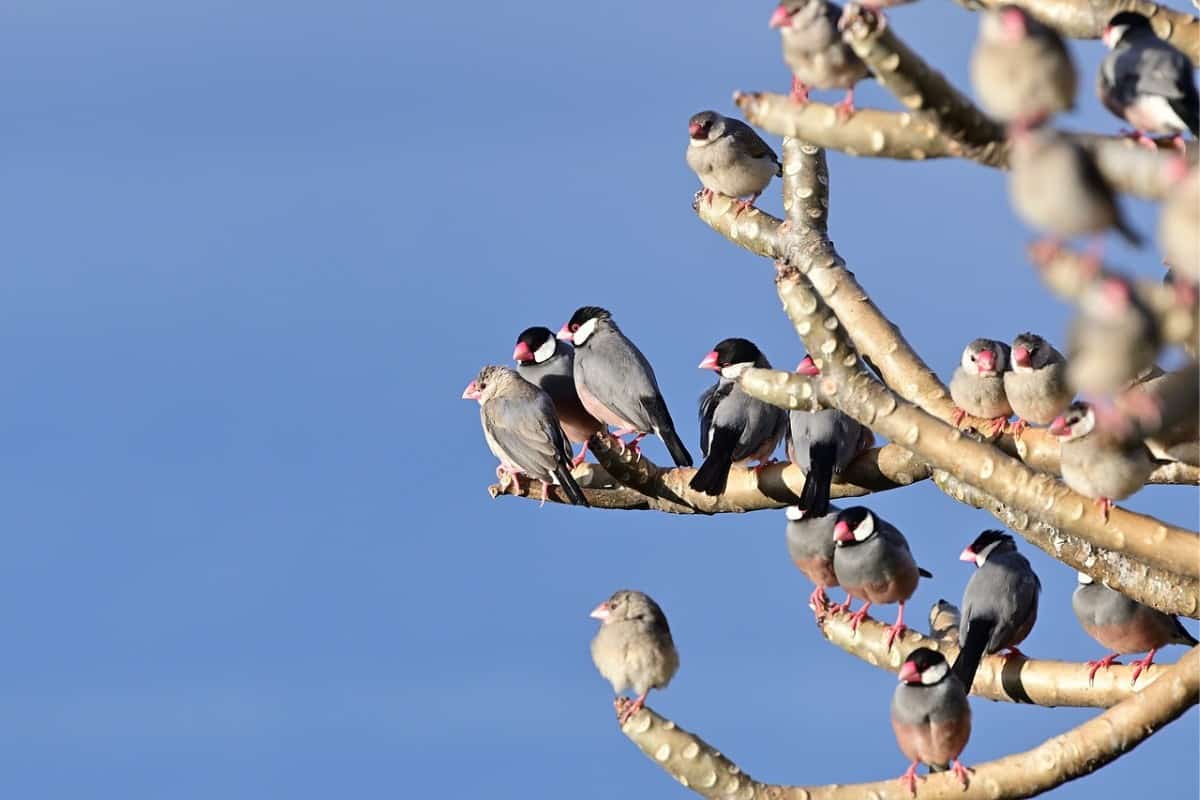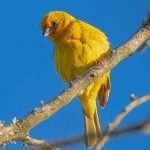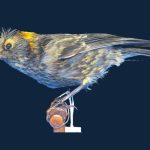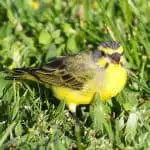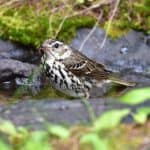Common Name: Java Sparrow
Scientific Name: (Padda oryzivora)| Size | Diet | Range in Hawaii | Status in Hawaii |
|---|---|---|---|
| 5.5 in. | grass seeds and weed seeds | O'ahu, Kaua'i, Moloka'i, Maui, and Big Island | Endangered |
The Java Sparrow, also known as Padda Oryzivora, is a small bird species that is native to Indonesia and other parts of Southeast Asia. However, it has also been introduced to other parts of the world, including Hawaii, where it has become a naturalized resident. Although it is a non-native species, the Java Sparrow has only recently been established in Hawaii, making it a relatively new addition to the islands’ avian population.
In this article, we will explore the fascinating world of the Java Sparrow, its unique characteristics, and its presence in Hawaii.
Java Sparrow
Appearance
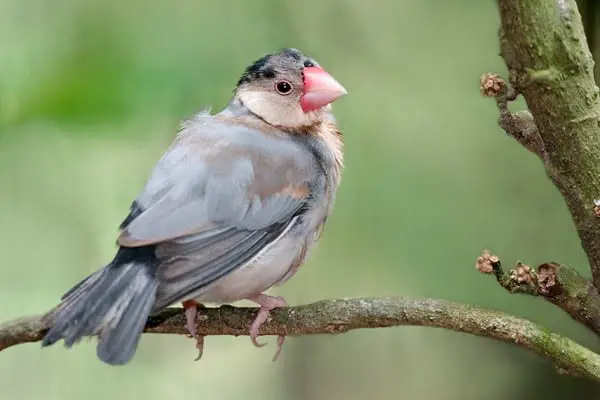
The Java Sparrow is a visually striking bird with a unique appearance. Standing at about 5.5 inches (14 centimeters) in length, it possesses a stout and compact build. The bird showcases a predominantly grey plumage, complemented by a black face mask that extends from its beak to its eyes.
Adding to its allure, the Java Sparrow displays a contrasting pinkish-red bill and feet. Males and females share a similar appearance, but males often exhibit a slightly darker and more intense coloration.
Diet
While their name might suggest a preference for rice, these birds actually have a varied palate. In the wild, they primarily feed on a combination of grass seeds, weed seeds, and various types of millet. They also have a fondness for insects and their larvae, which they capture on the wing or find in vegetation.
When kept as pets or in captivity, the diet of Java Sparrows can be supplemented with a mixture of seeds, including millet, canary grass seed, and small amounts of rice.
Nesting
These birds are known to form small colonies during the breeding season, often nesting in close proximity to each other. Their nests are typically built in trees, shrubs, or even in crevices of buildings.
The construction of their nests is a collaborative effort, with both male and female Java Sparrows participating in the process. They use various materials, such as twigs, grass, leaves, and feathers, to create a cup-shaped structure. The female takes the lead in shaping the nest while the male assists by gathering nesting materials.
Once the nest is ready, the female lays a clutch of eggs, usually ranging from 4 to 6 eggs. Both parents take turns incubating the eggs, ensuring they are kept warm and protected. The incubation period lasts around 12 to 14 days.
After hatching, the chicks are cared for by both parents. They are fed a diet consisting of regurgitated seeds and insects, providing them with the necessary nutrition for growth. The young Java Sparrows fledge and leave the nest after approximately three weeks, but they continue to receive parental care and guidance for some time.
The communal nesting behavior of the Java Sparrow showcases their social nature and cooperative breeding strategy. It’s a testament to the species’ ability to work together and ensure the successful rearing of their offspring.
Behavior
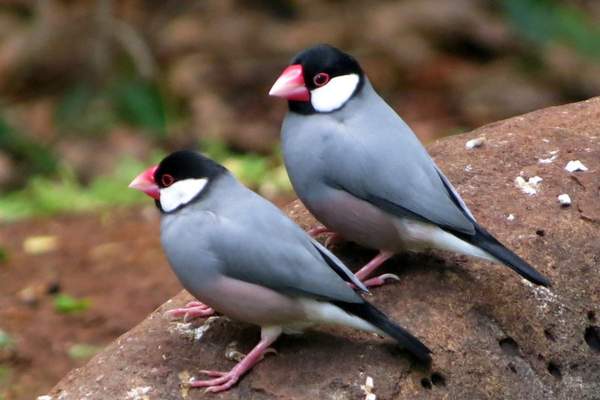
These birds are known for their gregarious behavior, often forming small flocks or colonies. They exhibit a strong affinity for their flock mates, engaging in various social interactions.
Communication is an integral part of their behavior. Java Sparrows use a variety of vocalizations, including chirps, trills, and soft warbles, to communicate with each other. These vocalizations serve to establish territories, attract mates, and maintain social bonds within the group.
Java Sparrows are agile and acrobatic flyers, capable of impressive aerial displays. They engage in swooping flights, twists, and turns, showcasing their agility and dexterity in the air. These flight displays are not only a form of exercise but also play a role in courtship rituals and territorial defense.
Another interesting behavior of Java Sparrows is their affinity for bathing. They thoroughly enjoy splashing and preening in water, whether it’s in shallow puddles or provided baths. Bathing helps them keep their feathers clean and in good condition, ensuring efficient flight and insulation.
Furthermore, Java Sparrows are known for their curious and playful nature. They are often seen engaging in exploratory behaviors, investigating their surroundings and objects within their environment. This inquisitive behavior contributes to their adaptability and ability to thrive in various habitats.
Habitat
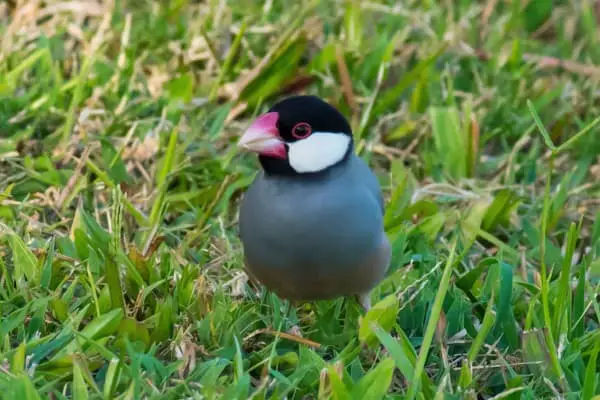
In their natural range, they inhabit open grasslands, agricultural fields, and scrublands with scattered trees. While in their introduced habitats, such as Hawaii, the Java Sparrow has adapted to a range of environments. They can be found in urban and suburban areas, parks, gardens, and even coastal regions.
Range
The Java Sparrow has established itself as a naturalized resident in Hawaii. Introduced in the 1960s, these vibrant birds rapidly spread across O’ahu, Kaua’i, Moloka’i, Maui, and Hawai’i Island. Their population has been associated with disturbance in neighborhoods, threats to agriculture, and the spread of noxious plants.
With sightings dating back to the early 1900s, the Java Sparrow’s presence in Hawaii has steadily increased, making them a common sight in coastal areas and lowlands. From Honolulu to Hilo, these charming birds have become a part of Hawaii’s avian landscape.
Conservation Status
The Java Sparrow (Padda oryzivora) is an avian species that currently faces conservation concerns. According to the International Union for Conservation of Nature (IUCN) Red List, it is classified as “Endangered.” This status indicates that the Java Sparrow is at a high risk of extinction in the wild if appropriate conservation measures are not taken.
Interesting Facts
1. Symbol of love
In Japan, the Java Sparrow is considered a symbol of love and devotion. It is often featured in traditional Japanese artwork and is highly regarded as a beloved pet bird.
2. Avian mimicry
In some cases, Java Sparrows have been observed mimicking the calls of other bird species. This ability to imitate sounds is believed to be a learned behavior and may serve as a form of communication within the flock.
3. Hybridization
Java Sparrows have been known to hybridize with other finch species, particularly in regions where they have been introduced. This hybridization can result in interesting variations in appearance and behavior.
4. Nest material theft
In some instances, Java Sparrows have been observed stealing nesting materials from other bird species’ nests. This behavior, known as kleptoparasitism, allows them to save time and energy by utilizing the materials gathered by other birds.
5. Agility in feeding
Java Sparrows display remarkable dexterity when feeding. They use their agile feet to hold seeds while pecking them open, a behavior known as “foot-feeding.” This technique allows them to extract the nutritious contents efficiently.
Frequently Asked Questions
1. How long do Java Sparrows live?
A9: In captivity, with proper care, Java Sparrows can live up to 10-12 years or even longer. Some individuals have been reported to live into their late teens or early twenties. A healthy diet, suitable living conditions, and regular veterinary care contribute to their longevity.
2. Are Java Sparrows prone to any specific health issues?
A11: Java Sparrows can be susceptible to certain health issues, including respiratory infections, parasitic infestations, and feather-related problems. Regular veterinary check-ups, a clean and hygienic environment, and a balanced diet help minimize the risk of these health concerns. Monitoring their overall well-being and seeking veterinary care if any abnormalities are observed is important.
3. Can Java Sparrows be released into the wild?
A15: If Java Sparrows have been kept in captivity, it is generally not advisable to release them into the wild. They may lack the necessary survival skills and could struggle to adapt to their natural habitat. Additionally, releasing non-native species can disrupt local ecosystems. It is best to enjoy and care for Java Sparrows responsibly in captive settings.
4. Are Java Sparrows protected by any laws or regulations?
A20: The legal protection status of Java Sparrows may vary depending on the country or region. In some areas, they may be protected under wildlife conservation laws or regulations. It’s important to check local laws and regulations regarding the possession, breeding, or trade of Java Sparrows to ensure compliance with legal requirements.
